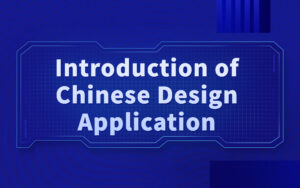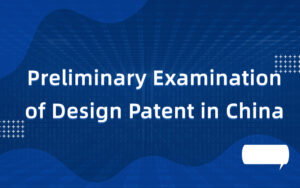Protectable Subject Matters of Utility Model Patents in China
In our previous article, we have provided a general introduction about the protectable subject matters of patents in China. Some applicants may still feel confused about the rules of utility model patents in China. Here, we will make a more detailed analysis in this respect.

In invention patents, methods, materials, and product shapes and/or configurations may appear simultaneously. However, methods and materials cannot be the protectable subject matters of utility model patents. How to determine whether the technical content of methods, materials combined with product shapes and/or configurations can be the protectable subject matters of utility model patents?
According to the provisions of Section 6.1, Chapter 2, Part 1 of Guidelines for Examination, “The name of the known method may be used in the claims of the utility model patent to define the shape and the configuration of a product, but operations, process conditions, etc. of the method shall not be contained. The claims contain the shape, the configuration, as well as the improvement proposed to the method itself, which does not belong to the protectable subject matters of utility model patents.” Therefore, it does not mean that the content of the method cannot appear in the utility model patent. It depends on whether the method is a known method.
According to the provisions of Section 6.2.2, Chapter 2, Part 1 of Guidelines for Examination, “The name of the known material can be contained in the claims of the utility model patent, that is, the name of the known material in the prior art can be applied to the product with the shape and configuration. The claims not only include the shape, configuration, but also the improvement of the material itself, which does not belong to the protectable subject matter of the utility model patent.” Therefore, it does not mean that the content of the material cannot appear in the utility model patent. It depends on whether the material is a known material.
Protectable subject matters of utility model patents are specifically described below with reference to examples, extracted from Section 6, Chapter 2, Part 1 of Guidelines for Examination.
Utility Model Patents in China – Protectable Subject Matters Example
- Example 1-1
A rain shoe made of rubber materials, wherein a proper position on an outer surface of the rain shoe is provided with a colored pattern.
Analysis: The purpose of providing a colorful pattern on the rain shoe is to play a role in aesthetic decoration and mood adjustment. It does not solve the technical problem and is not a technical solution. According to the provisions of Section 6.3, Chapter 2, Part 1 of Guidelines for Examination, this solution does not belong to the protectable subject matter of a utility model.
- Example 1-2
A high-strength anti-slip long barrel rain shoe, comprising a rain boot body (1), wherein a bottom outer wall of the rain boot body (1) is provided with a rubber sole (2), an inside of the rubber sole (2) is provided with a shock-absorbing and anti-slip assembly (3), and a strength rubber layer component (4) is provided on an outer wall of the rain boot body (1).
Analysis: First, the technical problem solved in this example is slip resistance. Second, although “rubber” materials appear in the claims, “rubber” is a known material. According to the provisions of Section 6.2.2 and 6.3, Chapter 2, Part 1 of Guidelines for Examination, this solution belongs to the protectable subject matter of a utility model.
Products protected by utility model patents shall be manufactured through industrial methods
- Example 2-1
A butterfly specimen, wherein the specimen is a Morpho hecuba.
Analysis: The Morpho hecuba is a kind of natural creature, which is unprocessed. According to the provisions of Section 6.1, Chapter 2, Part 1 of Guidelines for Examination, this solution is not the protectable subject matter of a utility model.
- Example 2-2
A plant gourd liquid container with a natural gourd as a body, wherein the gourd body is hollow, a groove is engraved in the middle of the gourd body, and a top of the body is provided with a perforation for hanging.
Analysis: The gourd is a raw material that has undergone industrial processing. According to the provisions of Section 6.1, Chapter 2, Part 1 of Guidelines for Examination, this solution is the protectable subject matter of a utility model.
- Example 2-3
A new type of plate, comprising a base plate, wherein an upper surface of the base plate is provided with a roughening layer, the roughening layer is provided with a spray coating layer that is formed by metal spraying on the roughening layer and is extruded.
Analysis: “Metal spraying process” and “extrusion” are both names that belong to the prior art. According to the provisions of Section 6.1, Chapter 2, Part 1 of Guidelines for Examination, this solution belongs to the protectable subject matter of a utility model patents.
Shapes of products protected by utility models shall be definite spatial shapes that the products have and can be observed from the outside.
It should be noted that some mechanical structures are precision structures, which cannot be observed directly by the human eye, and can only be seen clearly with the aid of a magnifying glass (for example, the precision structure inside a watch), but still belong to protectable subject matters of utility models.
- Example 3-1
A pile of steel pipes arranged in a trapezoidal shape, wherein the steel pipes are arranged in the trapezoidal shape.
Analysis: According to the provisions of Section 6.2.1, Chapter 2, Part 1 of Guidelines for Examination, a non-determined shape obtained by placing, stacking, etc. cannot be used as the shape feature of the product in the claims of a utility model patent, which, of course, cannot be used as the shape feature of the invention patent.
The configuration of a product protected by a utility model patent is the arrangement, organization and interrelationship of the various components of a product.
According to the provisions of Section 6.2.2, Chapter 2, Part 1 of Guidelines for Examination, the atomic structure, molecular structure, material composition, metallographic structure, etc. of the substance do not belong to the configuration of the product protected by the utility model patent. The composite layer can be considered as the configuration of the product. The carburized layer and the oxide layer of the product belong to the composite structure.
- Example 4-1
A light-weight thermal insulation floor heating brick, wherein equidistant positioning protrusions are arranged vertically and horizontally on a square plate-shaped brick body, and the raw material composition and weight percentage are: magnesium oxide 38%~50%, magnesium chloride 20%~28%, sawdust 1%~3%, rice husk 10%~13%, gypsum powder 10%~14%, and calcium hydroxide 3%~6%.
Analysis: Although the solution improves the shape and configuration of thermal insulation floor heating brick, it also includes material components. According to the provisions of Section 6.2.2, Chapter 2, Part 1 of Guidelines for Examination, this solution does not belong to the protectable subject matter of a utility model, however, this solution is the protectable subject matter of the invention patent.
- Example 4-2
A high-strength free-cutting cast iron, wherein a metallographic structure is 28% to 97% of ferrite and point graphite, and a metallographic structure of a central part is more than 92% of pearlite.
Analysis: This technical solution involves the improvement of the metallographic structure of cast iron. According to the provisions of Section 6.2.2, Chapter 2, Part 1 of Guidelines for Examination, this solution does not belong to the protectable subject matter of a utility model. However, this is the protectable subject matter of an invention patent.
- Example 4-3
For a product with a composite layer, the composite layer structure is to form different layers in a specific area through process processing and physical modification. The layer structure should be considered to belong to the configuration of the product.
For example, a stainless steel thin-walled and highly wear-resistant cylinder liner with a cylindrical outer circle whose body has a shaft shoulder folded outward at a right angle at one end, wherein the material of substrates of the outer circle and the shaft shoulder is stainless steel, and the outer circle substrate has a carburized layer from an inner surface from the inside to the outside, and a thickness of the carburized layer is 0.05~0.09 mm.
Analysis: The carburized layer forms a specific layer different from a substrate in a certain area from the inside to the outside on an inner surface of the substrate, and belongs to the composite layer protected by the utility model patent. Although the “stainless steel” material appear, this material is a known material, and according to the provisions of Section 6.2.2, Chapter 2, Part 1 of Guidelines for Examination, it belongs to the protectable subject matter of a utility model.
- Example 4-4
1. A new type of plate, comprising a base plate, wherein an upper surface of the base plate is provided with a roughening layer, the roughening layer is provided with a spray coating layer that is formed by metal spraying on the roughening layer and is extruded.
2. The new type of plate of claim 1, wherein the base plate is made of a magnesium alloy material or a lithium alloy material.
3. The new type of plate of claim 1, wherein the spray coating layer is composed of one or more layers of metal particles or metal powders.
Analysis: Regarding the claim 2 and the claim 3, although the types of material appear, “magnesium alloy”, “lithium alloy”, “metal particles” and “metal powders” are all known materials, according to the provisions of Section 6.2.2, Chapter 2, Part 1 of Guidelines for Examination, this solution belongs to the protectable subject matter of a utility model patent.
- Example 4-5
An electric heating mirror, comprising a power switch, a temperature control switch, a bracket, and a mirror body, wherein the mirror body is composed of three layers of materials: a mirror material, a mirror-making material and an electric heating component; the mirror-making material is coated with the mirror material and processed into the mirror surface through a mirror-making process, the electric heating component is installed behind the mirror-making material to form the mirror body, and the electric heating component is connected with the power switch; the power switch and the temperature control switch are arranged on the bracket, and the power switch is connected to a power cord and a plug to control the power switch and a temperature respectively.
Analysis: “Coating through a mirror-making process ” and “mirror-making material” belong to a currently known method and a currently known material. According to the provisions of Section 6.1, Chapter 2, Part 1, and Section 6.2.2, Chapter 2, Part 1 of Guidelines for Examination, this solution belongs to the protectable subject matter of a utility model patent.

